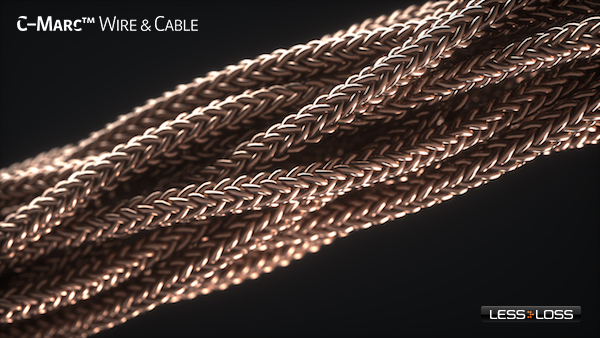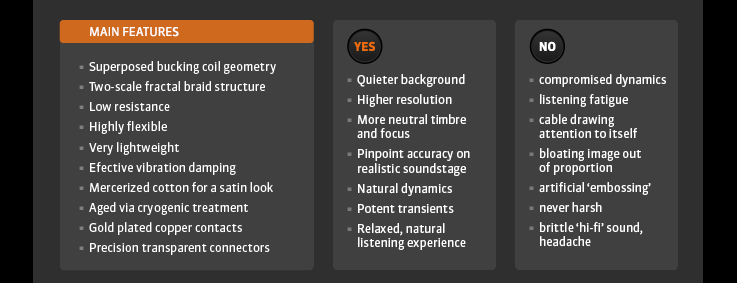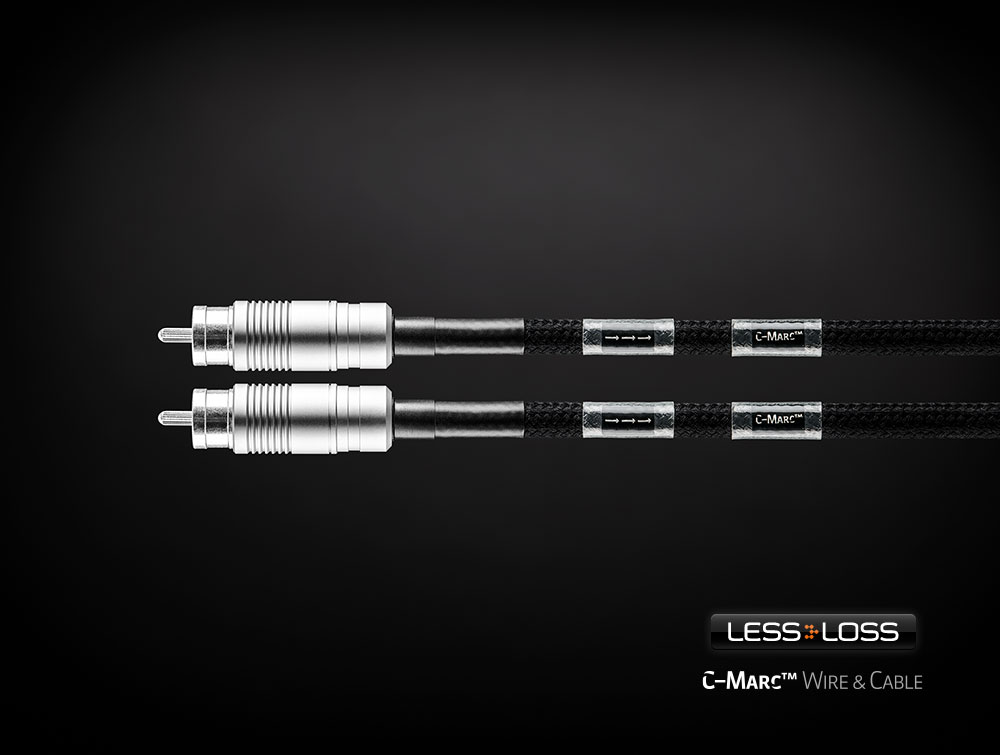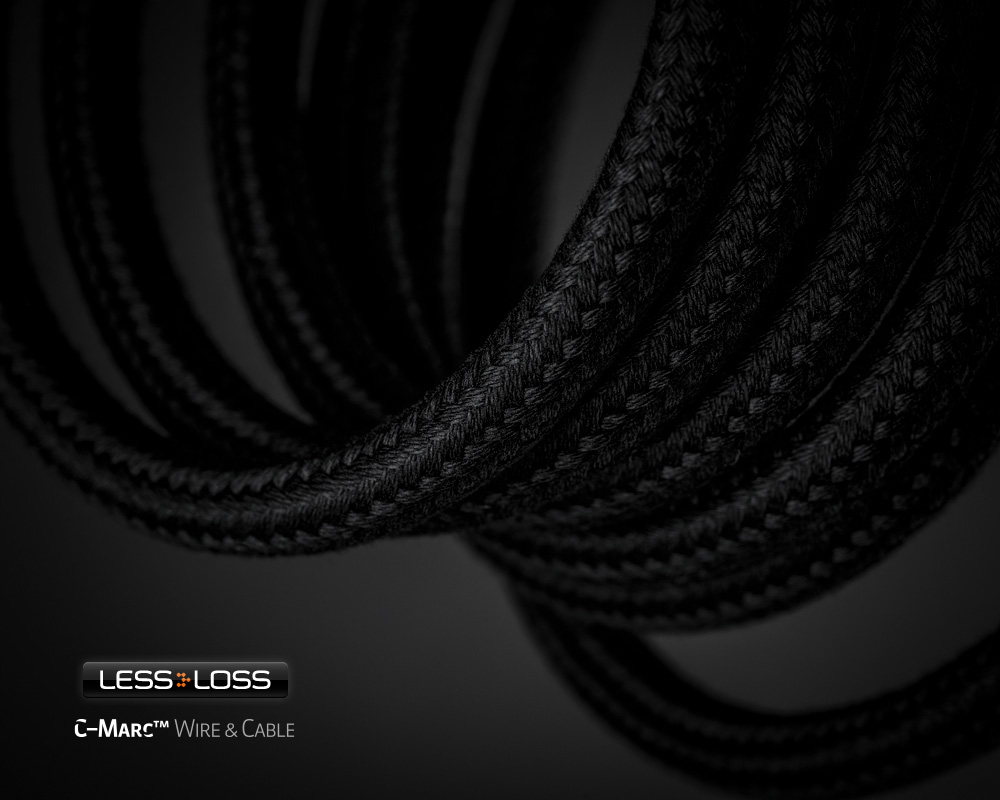LessLoss C-Marc Interconnects. Find a Better Cable for the Price! You won't.
At True Audiophile.
Available for Audio Concierge (in Home Demo)
We have consistently listened to audio cables in a quest to find the ultimate performance for price. We've known about the vaulted LessLoss line for a while and now we have become one of only 2 dealers in the U.S. to be given the privilege to offer the full line. A little much gushing? You won't think so when you hear them.-- True Audiophile Mini Review
Note* Standard Price is for a 1M cable or 3.2 Feet.
"The LessLoss cable loom helped me hear more deeply into recordings . . . a high compliment for any piece of audio gear." by Mark Blackmore | The Audio Beat 2019
Real customer review (read full review in Review Tab)
“The Less Loss C-Mark range is the most appealing and effective cabling and power treatment I have ever found at its price point and at those 2x or 3x above. To get to the punchline, a complete set — interconnects, speaker cables, digital coax, power cords, and C-Mark 64x for each component — delivered in my system (1) more focus and coherence around vocals and instrumentation along with a larger soundstage (2) less harshness around some highs; and (3) rich but controlled and tighter bass. The biggest improvement, however, is in the overall musicality and listening engagement which is MUCH higher with the C-Mark cable set for every genre of music I tried. The cabling allows the listener to shift focus from the cerebral aspects of critical listening in which each part of the musical performance is considered in a piecemeal manner to simply enjoying the music. For any one who values their system and is open to improvement, an audition of the full C-Mark kit is highly recommended..For any skeptics reading this, I had no interest in changing the cabling in any of my systems which were all performing well. Konstantin at Atilier 13 in Nashville offered to send me a C-Mark set at his expense just to see what I thought. In the end, the overall effect was so profound I purchased the full set — they were that good. At the C-mark price level, and at many price levels above, I have not found a better set of cabling that works equally well with tubes and solid-state, high efficiency horns and low efficiency two-way etc. C-Mark lets the inherent quality of whatever you have shine through to its fullest." H- New York
Available for Demo via Audio Concierge Nationwide
"This is definitely the cable to go for. It will literally blow you mind." PureSound Magazine
"A whale of a performer" - 6 Moons
... today’s C-MARC that scored far more points on ease of delivery, detail retrieval, smoothness, color range, sensible ambience, tangibility, control and dynamic contrasts. - Hifi Knights
How does the new C-MARC™ RCA Cable compare to the Anchorwave and Homage to Time?
The tonal character of C-MARC™ is more liquid, fluid, and resolves more detail from any recording. As good as the Homage to Time is, it is still made of plastic (albeit very high quality plastic with excellent characteristics). Over and beyond the improvement in C-MARC™ that it is made entirely of cotton and a very thin layer of clear lacquer instead of plastic, the extremely well balanced counter-polarized coil technique lowers the noise even further than the methods employed in Anchorwave and Homage to Time, so the overall result is one of both lowered noise as well as one of purer tonal character. It is very easy to recognize these improvement straight from the start, even without burn-in.
After about 14 days of settling, the sound quality becomes even more organic and life-like. C-MARC™ is here to stay for a very long time. We feel confident that after a few years it will be recognized and employed in many different manufacturers' loudspeaker and equipment as internal hook-up wire.
One further advantage of C-MARC™ over both Anchorwave and Homage to Time is its extreme flexibility and light weight. Thus, even sensitively placed lightweight gear has the very best conditions to maintain the fine vibration control of even the most delicately positioned special tuning feet. See the following image for an idea of C-MARC™ cable's flexibility.
C-MARC™. A new generation of high performance wire and cable, well-equipped to deal with today’s over-polluted electro-magnetic environment.
C-MARC™ is a new type of Litz wire. C-MARC’s noise reduction is based on the bucking coil method using two counter-polarized coils. Every strand's clock-wise turn aligns with a corresponding counter-clockwise turn of exactly mirrored diameter and step. The two resulting counter-polarized coils are mutually superposed. A second-scale fractal replication of the already bucking coils is then repeated. Through electrical cancellation of the induced noise, C-MARC™ provides an enormous signal-to-noise ratio in today's demanding environment.
C-MARC™ stands for Common-mode Auto-rejecting Cable.
C-MARC™ is unlike any other hookup wire or cable currently being produced. It is based on the bucking coil method of noise reduction, used most famously in twin coil pickup designs first developed in the mid-1930's to silence hum from electric guitars.
This type of guitar pickup was called the Humbucker because it 'bucks the hum,' i.e. noise, out of the desired guitar signal through phase cancellation of two counter-polarized inductors. When the inductors both induce a common signal, it is induced in opposite polarities by each coil. These opposite polarities then mutually cancel when the two counter-polarized noise currents are combined through simple electrical summation. Humbucking coils are also used in some microphone designs as well as in sensitive sensor technology where induced stray noise is not acceptable and the highest signal to noise ratio is desired.
LessLoss designs a new type of wire around the Humbucking principle
C-MARC™ wire is a special type of Litz wire. It features all of the known benefits of traditional Litz wire without Litz wire's disadvantage of being formed as an elongated coil (inductor).
Traditional Litz wire has these advantages over normal 'naked' multi-stranded wire and solid core wire:
- Litz wire has a greater ratio of surface area to cross sectional area, resulting in less phase smearing between lower and higher frequencies.
- Litz wire creates no distortions due to so-called “strand jumping” or diode effects resulting from loosely contacting oxide layers of adjacent naked strands.
- Litz wire is more flexible, practical and safer than solid core wire of the same large cross sectional area.
C-MARC™ wire shares all of the above advantages of traditional Litz wire, and advances the art with these additional unique benefits:
(1) Traditional Litz wire is bunched and then twisted in only one direction, leading to the formation an elongated group of uni-directional coils (inductors) of differing diameters, in structure resembling elongated overstretched springs of different sizes.
[fig. 1. (pending): Sketch of typical Litz structure where multiple coil diameters and single coil turn direction resemble several overstretched springs bunched together. This structure allows high speed of production.]
[fig. 2. (pending): Each long separately insulated Litz wire can be seen as a separate coil of a given diameter and step. The different diameters are a result of the bunching before mutual twisting.]
[fig. 3. (pending): Individual wires of differing thicknesses are bunched together to form different geometries. Many variations of Litz structure exist, most founded upon the main idea of first bunching and then twisting into spirals.]
"Type 7" Litz
[fig. 4. (pending): Some manufacturers offer braided Litz wire. This wire also is formed from initially bunched and mutually twisted strands before braiding. This type of wire is often referred to as Type 7 Litz wire and is compressed after braiding the twisted bunches into an overall rectangular shape before tape wrapping and over-extrusion.]
How C-MARC™ is profoundly different
In contrast, C-MARC™ wire goes down to the very fundamentals in a completely mirrored, balanced geometry. It aligns every Litz strand's clock-wise turn with a corresponding counter-clockwise turn of exactly mirrored diameter and step along the length of the wire. These two resulting spirals are mutually superposed in counter-braided fashion. Noise is thus induced in exactly opposite polarities and in exactly mirrored amplitudes, while the good signal is common to both spirals. The two counter-polarized noise signals mutually cancel when the two counter-polarized currents are combined through simple electrical contact at both ends of the wire. Thus, through auto-rejection of opposing electrical phase through summation at the ends, C-MARC™ wire perfectly counters the noise induction, whether from external sources or self-induced, which normally pollutes every other twisted Litz wire assembly. In this way, C-MARC™ wire achieves signal transfer which is corrupted substantially less than the industry has been able to achieve through other means.
[fig. 5. (pending): C-MARC™ Litz schematic layout. The clockwise and counter-clockwise spirals are mirrored in diameter, step and wire gauge, while at the same time being superposed in relation to one another. This results in opposite phase induction within the very structure of a single polarity line. While production speed is substantially slower, the silence of operation of C-MARC™ wire is far superior to standard Litz structures.]
(2) This is not all. LessLoss C-MARC™ wire features two-scale "fractal" replication of the aforementioned mutually superposed counter-twisted layout. This mirrored and nested structure further enhances the mutual cancellation of counter-polarized inductive twists, while at the same time allowing enlarged overall cable cross-sectional designs which serve to further lower resistance without at all sacrificing signal fidelity or flexibility. 
[fig. 6.: C-MARC™ shown in two-scale fractal replication. Everything that occurs geometrically at the core level is again repeated at the larger level, thus further reducing induction of noise. Just as the initial clockwise and counter-clockwise spirals are mirrored in diameter, step and wire gauge, while at the same time being superposed in relation to one another, so, too, at the larger level. This makes the cable a very silent performer while not influencing the natural tone color of sensitive signals throughout the frequency spectrum.]
What this means
C-MARC™ is intrinsically the most silent wire on the planet and provides pure transmission of signal. The degree of silence of the working solution is in direct proportion to the degree of superposition of the counter-polarized twists as well as in the degree of their mirrored equality in terms of turn radius, step and resistance. The idea being that in the best of worlds, both opposite "polarities" of a single lead of C-MARC™ wire induce the exact same noise, and a perfect summation to zero will result at both ends of the line.
(3) Because the individual enameled wires which make up the unique Litz structure of the C-MARC™ wire are so small in diameter (0.125mm), this further enlarges the ratio between total surface area and total cross section for even better phase relationship along the entire spectrum.
(4) This structure further enhances flexibility and ease of bed on any axis, especially for large cross section cables, without unnecessarily enlarging the entire cable assembly.
(5) The strands used in C-MARC™ wire are covered with thinnest technically possible colorless enamel. They are solderable once tinned in a soldering pot.
(6) There is no plastic throughout; instead, C-MARC™ wire and cables are insulated with tightly braided 100% natural, gassed and macerated cotton fiber with double coverage for added protection. This results in a very lightweight, highly flexible, naturally sounding product with today's best performance characteristics for delicate audio applications with an enormous signal-to-noise ratio.


How does the new C-MARC™ Cable compare to the DFPC Reference?
The tonal character of C-MARC™ is more liquid, fluid, and resolves more detail from any recording. As good as the DFPC Reference is, it is still made of plastic (albeit very high quality plastic with excellent characteristics). Over and beyond the improvement in the C-MARC™ power cord that it is made entirely of cotton and a very thin layer of clear lacquer instead of plastic, the extremely well balanced counter-polarized coil technique lowers the noise even further than the very effective skin-filtering employed in the DFPC Reference, so the overall result is one of both lowered noise as well as one of purer tonal character. It is very easy to recognize these improvement straight from the start, even without burn-in.
Another improvement is found in the connectors. In C-MARC™ they are not made of brass, but are pure copper. And instead of glass filler in the black plastic of the housing, entirely clear and extremely stable plastic is used. And if that weren't enough, these connectors are cryogenically treated, whereas the 079's were not.
All of these improvements add up to provide obviously superior results, straight from the outset. After about 14 days of settling, the sound quality becomes even more organic and life-like. C-MARC™ is here to stay for a very long time. We feel confident that after a few years it will be recognized and employed in many different manufacturers' loudspeaker and equipment as internal hook-up wire.
One further advantage of C-MARC™ over the DFPC Reference is its extreme flexibility and light weight. Thus, even sensitively placed lightweight gear has the very best conditions to maintain the fine vibration control of even the most delicately positioned special tuning feet. See the following image for an idea of C-MARC™ cable's flexibility.
[[[proreview_start]]]
"The LessLoss cable loom helped me hear more deeply into recordings . . . a high compliment for any piece of audio gear." by Mark Blackmore | The Audio Beat 2019 Read Full Review Here
Full compliment C-Mark
H - New York
“The Less Loss C-Mark range is the most appealing and effective cabling and power treatment I have ever found at its price point and at those 2x or 3x above. To get to the punchline, a complete set — interconnects, speaker cables, digital coax, power cords, and C-Mark 64x for each component — delivered in my system (1) more focus and coherence around vocals and instrumentation along with a larger soundstage (2) less harshness around some highs; and (3) rich but controlled and tighter bass. The biggest improvement, however, is in the overall musicality and listening engagement which is MUCH higher with the C-Mark cable set for every genre of music I tried. The cabling allows the listener to shift focus from the cerebral aspects of critical listening in which each part of the musical performance is considered in a piecemeal manner to simply enjoying the music. For any one who values their system and is open to improvement, an audition of the full C-Mark kit is highly recommended and I would say should be nearly a requirement for anyone starting a system from scratch.
For those for whom some more detail might be of interest — I currently have three high end systems, each with a different character. Over the years, I have seriously listened to a dozen different brands of cabling and power conditioning at a range of price points commesurate with the level of investment in each overall system. Virtually all sets of cables were above the price of a full C-Mark set -- at times many multiples above. Each set of cables had pros and cons and some stayed in each system and when they did, it would be the full set of cables for coherence. Often moving from one set cables to another in each system usually changed one or two aspects of the presentation of the music. At times, while there was shift, the “net” result was not an improvement in my judgement. Other times, there was a “net” improvement but there remained a weakness in some aspect. The “best” cabling in my judgement lowers the noise floor of the system and “stays out” of the way as much as possible.
In many circumstances, the specific character of a set of cables can be used to compensate for the opposite characteristics the components possess. For example, “bright” cabling can compensate for a “dark” set of components. In my experience, this approach always leaves a sub-optimal net result but may be the most practical approach given the components in question. C-Mark’s character is neutral and I could not discern any particular emphasis the cables brought — they were not brighter or darker; they didn’t accentuate one part of the recording over the others; they did not appear to be faster or slower than other cables etc. Their main effect was to increase the effortlessness and fluidity of the music while improving the coherence and size of the soundstage. Imagine a sort of haze around the band or orchestra members that other cables impart or allow — C-Mark simply eliminated the haze (and occasional harness around some highs). In this sense, I believe C-Mark is likely eliminating various types of noise and interference present within and among the comments of the system, letting each play its role in the music delivery with minimal negative artifacts introduced. The net result was a notable increase in musicality and engagement with the music.
For anyone considering C-Mark one step at a time, my suggestion would be to start with either speaker cables or power cords. If it is possible to audition the whole set, even if finances may preclude the purchase of a whole set at once, I would recommend doing so, so that the full potential of the system in question can be heard with comprehensive C-Mark cabling.
For any skeptics reading this, I had no interest in changing the cabling in any of my systems which were all performing well. My U.S. dealer offered to send me a C-Mark set at his expense just to see what I thought. In the end, the overall effect was so profound I purchased the full set — they were that good. At the C-mark price level, and at many price levels above, I have not found a better set of cabling that works equally well with tubes and solid-state, high efficiency horns and low efficiency two-way etc. C-Mark lets the inherent quality of whatever you have shine through to its fullest.
Literally over 100 Pro and Consumer rave reviews. Here's small sampling:
"I wish I could have used [these] to teach this concept to my students."
April, 2019, author: Mark Blackmore, music educator
"I was immediately surprised at how much more information was spread across my living room. Reverb went on forever and the whole soundstage of the prelude seemed much larger and deeper."
"The LessLoss interconnects certainly revealed more detail than I thought possible from my DAC, and it occurred to me that until then, I hadn't really heard all that the BorderPatrol DAC had to offer."
"Quick attacks." "No sense of blur." "Huge soundstage."
"Increased sense of soundstage width and depth."
"Improved resolution and focus in the upper bass and lower midrange."
"I could more clearly hear the performer's technique, the instrument's character, and the idiosyncrasies of the performance."
"I listened to Andre Previn's After Hour's with Ray Brown and Joe Pass CD [Telarc CD83302], noticing a specific benefit of this improved clarity. In music education, we teach that great jazz bass players will play on the "front side" of the beat, enhancing the excitement of an up-tempo tune without rushing the beat. Alternately, the bass player will need play on the "back side" of the beat for ballads or the blues, for that lazy, but not late, groove. On "There'll Never Be Another You", Ray Brown drives the trio with a percussive right-hand technique, always on the front edge of the beat, to propel the tempo forward. The LessLoss cables conveyed greater insight into Brown's musicianship and his ability to play a melodic bass line while also acting as the percussive drive for this drummerless trio tune. I wish I could have used a similarly revealing system to teach this concept to my students."
"Image definition was definitely improved. The sound was purer, more focused, yet retained good extension."
"The LessLoss speaker cables [on electrostatic loudspeakers] did a fine job, with improved image location and depth. Owners of electrostatic speakers should certainly add them to their audition list. They seem made for use with electrostats."
"The change was equivalent to swapping a good preamp for a really great preamp."
"Every aspect of the sound was improved, but most notable was the treble, which had been too forward before, with the tweeter being much too obvious. The improvements exceeded those in my own system, and the owner texted me many times in the following days in amazement at the effect of inserting just one LessLoss power cord. I doubt I would have believed this story if I hadn't witnessed the outcome myself. This was certainly the best sound I've heard at his house."
"Prior to adding the LessLoss cables, I had auditioned many cables in the same general price range, and one power cord that was three times as expensive. While all were well made and sounded good, none of them made my system sound better in terms of bringing performers and their craft into my listening room. The LessLoss cable loom helped me hear more deeply into recordings, and I spent more of my listening time thinking about the musician's performance rather than the sound of the system. That is a high compliment for any piece of audio gear."
"The [LessLoss] cables' inclusion in my system removed a previously unnoticed level of confusion, or noise, resulting in clearer soundstage cues, cleaner upper bass and vocals, and greater overall musical enjoyment. The results were positive enough that I'm saving my audio money to add a set of interconnects and a power cord for my BorderPatrol DAC SE."
"a major win" "an arsenal of universally useful traits"
"voice rendered spot on, delicate and fleshy, yet distinct, precise and suspended in a breathing living space"
"supportive bass line didn't skip a beat and was fully controlled."
"evenly sorted across the entire audible range."
"perfectly composed, outlined and textured in a way that was fleshy and free from any hints of nervousness."
"more realistic"
"that instrument's every string pluck felt powerful, resonant, substantial and sustained"
"smoother, weightier and lingering in the air a bit longer."
"On dynamic range, smoothness, instrumental hydration and fine soft edges, the LessLoss clearly took the cake without second guesses."
"its in-built silencing action greatly contributed to rendering surrounding space as breathing, touchable and three-dimensional for a very pleasant "alive" feel."
"rendered the same image closer and partially bent around, to effectively surround me by it to a larger degree."
"had all outlines in check and didn't feel unclear at all."
"landed more pleasing, weightier sonics overall. That was a major win by my standards."
"more connected, coherent, heftier and nimble"
"substantial, vibrant and mighty without subtracting anything from its original character"
"scored higher on firm instrumental structures and humane artful vocal line."
"This fully-fledged C-MARC is geared for a particularly fetching silence and associated spatial blackness upon which all else blossoms."
"more than enough to elevate performance of a vast majority of setups I can think of, and keep any listening fatigue at the door."
"tonally even and safe, the risk of their counter-productive input is vanishingly low."
"In this context today's product wasn't designed to repair, but rather support a sonic outcome already achieved and to preserve and cherish its character."
"working extremely well in my main audio system."
"highly organic and resolving"
"did a splendid job."
"arsenal of universally useful traits"
"proved far less situational than most cables I've come across."
"Its wooden laser-engraved bullets turn it into one gorgeous looker"
"exceptionally slinky, so it's very easy to use."
"utmost obedient mechanical behavior."
"scored far more points on ease of delivery, detail retrieval, smoothness, color range, sensible ambience, tangibility, control and dynamic contrasts."
"superiority across pretty much the entire gamut"
"profound potency and subsequent impact"
"spatially extremely gifted, properly radiant, sensual, articulate and earthy at the same time"
"spectacular effects, simple as that."
[[[proreview_end]]]











